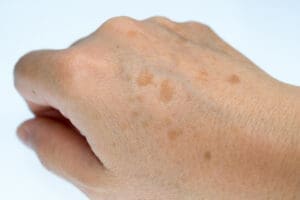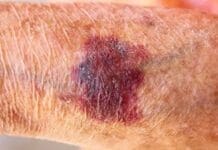 By Bridget Sullivan, PA-C, Coastal Skin Surgery and Dermatology, PCB
By Bridget Sullivan, PA-C, Coastal Skin Surgery and Dermatology, PCB
There are myriad types of lesions and growths on our body. Some look worrisome, but can be benign and non-cancerous while the opposite can also be true. It is hard to know the difference between what is worrisome and possibly cancerous and what is not. The goal of this article is to bring clarity on many common pigmented, or brown growths that we see on our skin and the signs and symptoms of what could possibly be cancerous or precancerous lesions.
 A lot of my patients will ask me “What are all these brown spots on my skin?” The majority of the time they are a seborrheic keratosis or lentigines. A lentigo or (plural, lentigines) is defined as a pigmented macule that results from sun exposure. These are the flat brown spots that you typically see in sun-exposed areas – hands, arms, legs, face. I’ve heard some patients refer to these as “liver spots.” These are more of a cosmetic concern and not concerning for cancerous or precancerous lesions. There are different methods to get rid of these lesions which should be discussed with your dermatology provider.
A lot of my patients will ask me “What are all these brown spots on my skin?” The majority of the time they are a seborrheic keratosis or lentigines. A lentigo or (plural, lentigines) is defined as a pigmented macule that results from sun exposure. These are the flat brown spots that you typically see in sun-exposed areas – hands, arms, legs, face. I’ve heard some patients refer to these as “liver spots.” These are more of a cosmetic concern and not concerning for cancerous or precancerous lesions. There are different methods to get rid of these lesions which should be discussed with your dermatology provider.
Another common brown lesion that I commonly get asked about is called seborrheic keratosis. These are also non-cancerous growths that can be described as pigmented or brown velvety or waxy stuck on growths. There is no known cause for these lesions and they can appear anywhere on the body. These can become inflamed and irritated and can be treated by your dermatology provider.
Lastly, we have moles or nevi on our skin that come in many different shapes, sizes and colors. They can be raised, flat, brown, or flesh color. It is important to know the ABCDE’s of melanoma when looking at your moles. The ABCDE’s are as follows: Asymmetrical, irregular or scalloped Border, Color (black or varying in color), Diameter (greater than 6mm or the size of a pencil eraser) and Evolution (if a mole changes). If any mole or growth itches, bleeds, hurts, or doesn’t heal after several weeks it is important to get these lesions evaluated by your dermatology provider.
I hope this article has brought clarity and understanding to many common growths that we see on our body. If you have any worrisome brown spots or any brown or black lesions that show any signs or symptoms of irregularities reach out to your dermatology provider for an evaluation. Prevention and early detection is key in skin cancer.
Visit COASTALSKINSURGERY.COM.





















































